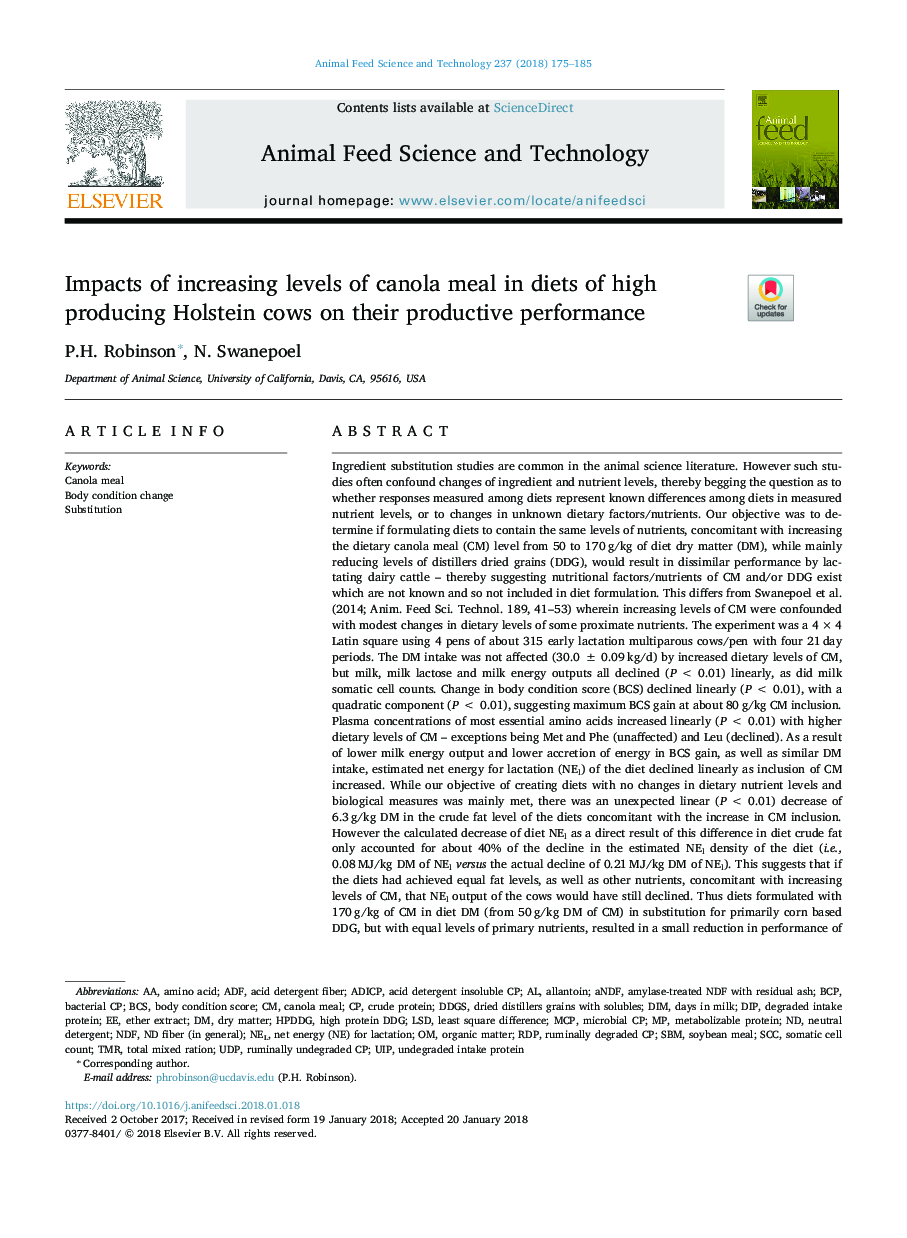| کد مقاله | کد نشریه | سال انتشار | مقاله انگلیسی | نسخه تمام متن |
|---|---|---|---|---|
| 8491019 | 1552349 | 2018 | 11 صفحه PDF | دانلود رایگان |
عنوان انگلیسی مقاله ISI
Impacts of increasing levels of canola meal in diets of high producing Holstein cows on their productive performance
ترجمه فارسی عنوان
اثرات افزایش سطوح وعده غذایی کانولا در رژیم های گاوهای تولید کننده هلشتاین تولید شده بر عملکرد تولیدی آنها
دانلود مقاله + سفارش ترجمه
دانلود مقاله ISI انگلیسی
رایگان برای ایرانیان
کلمات کلیدی
BCPDIPacid detergent insoluble CPmicrobial CPDDGSUIPUDPTMRSBMRDPLSDSCCMCPaNDFNDFADFADICPAllantoin - آلتوئینamino acid - آمینو اسیدDIM - اذعانacid detergent fiber - الیاف پاک کننده اسیدSomatic cell count - تعداد سلول های سوماتیکSubstitution - جایگزینیDried distillers grains with solubles - دانه های خشک شده با محلول های غلیظNEL - درdays in milk - روز در شیرBCs - روند BCsether extract - عصاره اترCanola meal - غذای کانولاorganic matter - ماده آلیdry matter - ماده خشکneutral detergent - مواد شوینده خنثیBody condition score - نمره وضعیت بدنcrude protein - پروتئین خامmetabolizable protein - پروتئین متابولیزه کنندهdegraded intake protein - پروتئین مصرفی کاهش یافته استtotal mixed ration - کل جیره مخلوط شدهundegraded intake protein - کمبود پروتئین مصرفیSoybean meal - کنجاله سویا
موضوعات مرتبط
علوم زیستی و بیوفناوری
علوم کشاورزی و بیولوژیک
علوم دامی و جانورشناسی
چکیده انگلیسی
Ingredient substitution studies are common in the animal science literature. However such studies often confound changes of ingredient and nutrient levels, thereby begging the question as to whether responses measured among diets represent known differences among diets in measured nutrient levels, or to changes in unknown dietary factors/nutrients. Our objective was to determine if formulating diets to contain the same levels of nutrients, concomitant with increasing the dietary canola meal (CM) level from 50 to 170â¯g/kg of diet dry matter (DM), while mainly reducing levels of distillers dried grains (DDG), would result in dissimilar performance by lactating dairy cattle - thereby suggesting nutritional factors/nutrients of CM and/or DDG exist which are not known and so not included in diet formulation. This differs from Swanepoel et al. (2014; Anim. Feed Sci. Technol. 189, 41-53) wherein increasing levels of CM were confounded with modest changes in dietary levels of some proximate nutrients. The experiment was a 4â¯Ãâ¯4 Latin square using 4 pens of about 315 early lactation multiparous cows/pen with four 21â¯day periods. The DM intake was not affected (30.0â¯Â±â¯0.09â¯kg/d) by increased dietary levels of CM, but milk, milk lactose and milk energy outputs all declined (Pâ¯<â¯0.01) linearly, as did milk somatic cell counts. Change in body condition score (BCS) declined linearly (Pâ¯<â¯0.01), with a quadratic component (Pâ¯<â¯0.01), suggesting maximum BCS gain at about 80â¯g/kg CM inclusion. Plasma concentrations of most essential amino acids increased linearly (Pâ¯<â¯0.01) with higher dietary levels of CM - exceptions being Met and Phe (unaffected) and Leu (declined). As a result of lower milk energy output and lower accretion of energy in BCS gain, as well as similar DM intake, estimated net energy for lactation (NEl) of the diet declined linearly as inclusion of CM increased. While our objective of creating diets with no changes in dietary nutrient levels and biological measures was mainly met, there was an unexpected linear (Pâ¯<â¯0.01) decrease of 6.3â¯g/kg DM in the crude fat level of the diets concomitant with the increase in CM inclusion. However the calculated decrease of diet NEl as a direct result of this difference in diet crude fat only accounted for about 40% of the decline in the estimated NEl density of the diet (i.e., 0.08â¯MJ/kg DM of NElversus the actual decline of 0.21â¯MJ/kg DM of NEl). This suggests that if the diets had achieved equal fat levels, as well as other nutrients, concomitant with increasing levels of CM, that NEl output of the cows would have still declined. Thus diets formulated with 170â¯g/kg of CM in diet DM (from 50â¯g/kg DM of CM) in substitution for primarily corn based DDG, but with equal levels of primary nutrients, resulted in a small reduction in performance of lactating dairy cows for reasons which are unknown, but may relate to lower conversion of digestible to metabolizable energy of the soluble carbohydrate fraction of CM versus DDG.
ناشر
Database: Elsevier - ScienceDirect (ساینس دایرکت)
Journal: Animal Feed Science and Technology - Volume 237, March 2018, Pages 175-185
Journal: Animal Feed Science and Technology - Volume 237, March 2018, Pages 175-185
نویسندگان
P.H. Robinson, N. Swanepoel,
